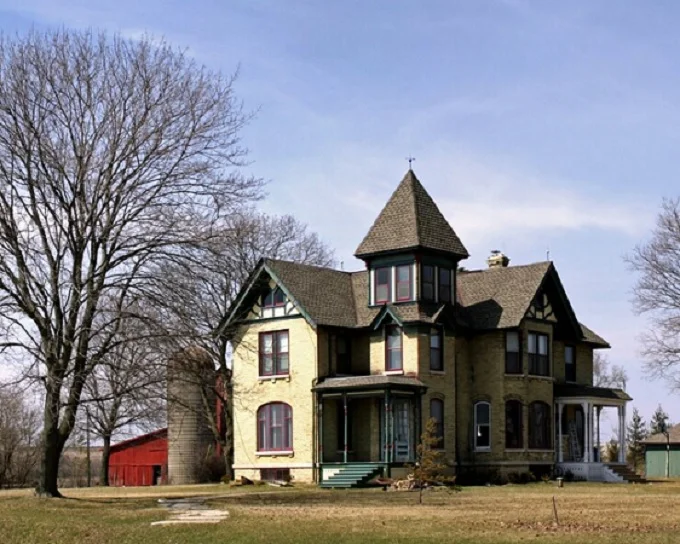The haunted dwelling at 112 Ocean Avenue in Amityville, New York, has captured public imagination for over 40 years. This suburban Dutch Colonial home was the site of a tragic mass murder in 1974 and claimed paranormal events in 1975 that spawned books and movies that still captivate horror fans today. Let’s examine the chilling true story behind this notorious spooky residence on Long Island.
The DeFeo Family Tragedy
On November 13, 1974, the quiet suburban community of Amityville was shattered when 23-year-old Ronald “Butch” DeFeo Jr. killed his entire family inside 112 Ocean Avenue. Using a .35 caliber Marlin rifle, DeFeo shot his parents and four siblings execution-style as they slept in their beds. The victims were Ronald DeFeo Sr. (43), Louise DeFeo (42), Dawn DeFeo (18), Allison DeFeo (13), Marc DeFeo (12), and John Matthew DeFeo (9).
DeFeo changed his story several times when questioned by police, but eventually confessed to committing the six brutal killings alone. DeFeo died in prison on March 12, 2021, at age 69, after serving multiple life sentences at Sullivan Correctional Facility in New York. The shocking mass murder rocked the small town and left the fate of 112 Ocean Avenue uncertain.
The Lutz Family and the Haunting Claims
In December 1975, newlyweds George and Kathy Lutz purchased the DeFeo house in Amityville House at a significantly reduced price of $80,000. The couple moved in with their three children, hoping for a fresh start despite the home’s tragic history.
The Alleged Paranormal Activity
Soon after moving into the supernatural dwelling, the Lutzes began experiencing what they claimed were paranormal phenomena. These strange events included foul odors, extreme temperature fluctuations, objects moving on their own, and dark apparitions. The extraordinary occurrences escalated over the 28 days they lived in the house.
The most chilling encounters reported by the Lutz family included:
- Green slime oozing from the walls
- Swarms of flies gathering in a room for no apparent reason
- George’s recurring nightmares of the murders
- Kathy levitating above her bed
- Strange voices and noises
- An unseen force slamming doors and windows
Frightened by the escalating paranormal activity, the Lutzes fled the house with their children and belongings, never to return.
Media Attention and Public Response
When the Lutzes shared their account of a cursed residence in Amityville, it quickly gained momentum in the press and sparked a national phenomenon. Their story was picked up by national outlets like the Los Angeles Times and was featured in a 1977 book called “The Amityville Horror” by Jay Anson.
The book became a bestseller and was adapted into a popular horror film starring James Brolin and Margot Kidder that same year. The gripping story of a supposedly real haunted property captivated audiences and helped cement Amityville’s reputation as a center of paranormal activity. Despite skeptics, it remains one of the most iconic haunted house stories in American history.
The Amityville House in Popular Culture
The Amityville House case became firmly entrenched in popular culture thanks to successful book and film adaptations. Let’s explore its influence over the years.
Books and Movies
Jay Anson’s 1977 horror book “The Amityville Horror” was a huge hit that spent over a year on the New York Times bestseller list. The 1979 film adaptation made more than $80 million and spawned numerous sequels over the following 40 years. Major films included “Amityville II: The Possession” (1982), “The Amityville Horror” (2005) starring Ryan Reynolds, and the later “Amityville: The Awakening” (2017).
Paranormal Investigations
In 1976, the famous paranormal investigators Ed and Lorraine Warren were called to assess the Lutzes’ claims of a ghostly abode. The Warrens confirmed the supernatural activity and became involved with the story. Their accounts added credibility in the eyes of believers, but skeptics viewed the story with suspicion. Debate continues today among paranormal investigators about what occurred in the Amityville House after the DeFeo murders.
Legal and Real Estate Issues
The fame of the notorious mansion led to numerous lawsuits over the years, particularly regarding the Lutzes’ account. Here are some of the major legal and real estate impacts.
Court Battles and Lawsuits
In 1977, William Weber, Ronald DeFeo’s defense attorney, filed a lawsuit claiming the Lutzes’ story was a hoax orchestrated as a fraudulent business scheme. In the September 17, 1979, issue of People magazine, William Weber wrote: “I know this book is a hoax. We created this horror story over many bottles of wine.”
During the trials, the Lutzes admitted that virtually everything in The Amityville Horror was pure fiction, according to reports in the Skeptical Inquirer.
In 2000, George Lutz sued entertainment companies for defamation, eventually settling out of court.
Real Estate Challenges
After the Lutzes fled in 1976, the house sat empty for over a year. Local children vandalized it regularly.
The address was changed to 108 Ocean Avenue after new owners found no one would buy it at 112 Ocean Avenue. However, this didn’t stop gawkers.
For decades, owners of the house have reported break-ins, trespassing, and harassment by people seeking paranormal thrills.
Current Interest
While public fascination with the Amityville House has varied over the years, it remains an intriguing paranormal destination today.
Current Status of the House
The iconic house still stands at 108 Ocean Avenue in Amityville, though its current owners are unidentified. The most recent sale was in 2017 for $605,000 to an anonymous buyer. Exterior renovations have modernized its appearance from the iconic 1979 film version.
Tourist Destination and Public Interest
The Amityville House continues to attract paranormal enthusiasts regularly. Tourists drive by daily, hoping to spot ghosts or supernatural signs. The town of Amityville embraces the phenomenon, hosting haunted tours and events around Halloween. Despite skeptics, the public’s interest in the home’s dark history endures.
The Amityville House case paved the way for greater mainstream interest in true crime hauntings. It inspired books like “The Shining” and shows like “American Horror Story.” For many people, this Long Island allegedly haunted location represents the quintessential American horror story – a blend of true crime, paranormal thrills, and psychological tension that still captivates us today.
The Hoax Allegations
The truth behind The Amityville Horror was finally revealed when Butch DeFeo’s lawyer, William Weber, admitted that he, along with the Lutzes, “created this horror story over many bottles of wine.” The house was never really haunted; the horrific experiences they claimed were simply made up.
Multiple investigations by parapsychologists and researchers have found significant evidence that the story was fabricated for financial gain. Weber told the Lutzes that a neighbor’s cat would peer into the DeFeos’ window at night. That became the red-eyed pig. Ronald DeFeo’s father had once hit his mother while she held a plate of red-sauced spaghetti. That became the mysterious red goo on the wall that morphed into green slime bubbling from keyholes.
Conclusion
The haunting events at the Dutch Colonial Amityville House, both real and imagined, have secured the house’s notoriety for more than 40 years. The tragic DeFeo murders, the frightened Lutz family’s experiences, and the ensuing media storm that followed launched 112 Ocean Avenue into the pantheon of famous haunted places. Despite controversy over its authenticity, the Amityville Horror endures as a chilling real estate horror story, keeping this suburban New York house in the spotlight. Next time you drive past a Dutch Colonial, you might wonder about the secrets held within.




No Comment! Be the first one.